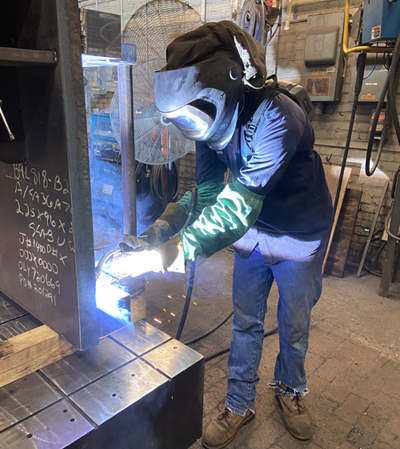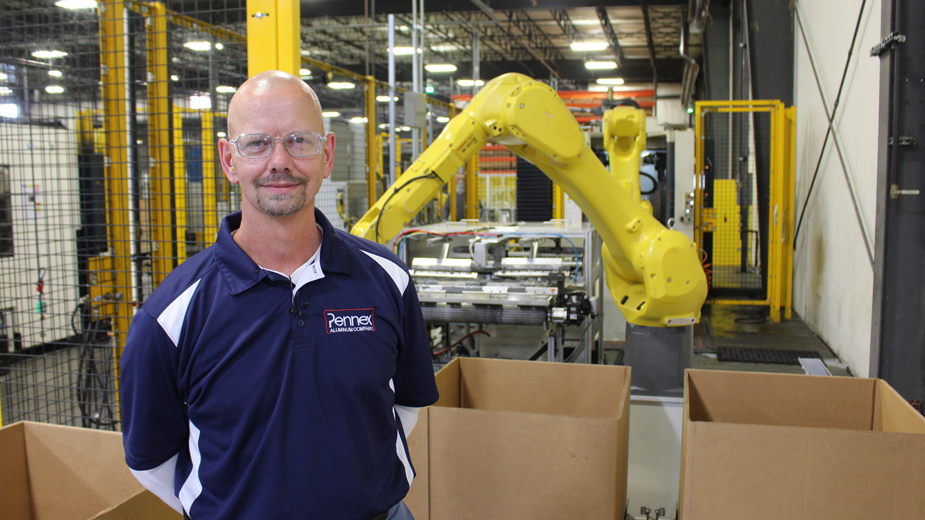YOUNGSTOWN, Ohio – The robotic arms move as if in a choreographed dance, checking recently cut aluminum parts for imperfections before being finished in a computer numerical control machine, then packed for shipping.
Robots operate in several caged cells on the floor of Pennex Extruded Products in Leetonia. An operator loads a long piece of extruded aluminum into the machine that cuts the parts for the robots to inspect.
In the past, repetitious tasks around mechanical equipment could result in recordable and, in some cases, serious injury to workers, like the loss of a finger, says the company’s president, Chuck Stout. Now, operators interrupt the process if something goes wrong. Otherwise, they are hands off.
“All they do is monitor,” Stout says. “Once he loads that, he never touches it again.”
When the door to the cage is opened, the robots shut off. The operator slides the padlock in the latch, so nobody can accidentally close the door while he is inside.
Automation and robots are among the most prominent changes to manufacturing since Stout took his first job in 1996, he says. Pennex has invested in automation to keep people as separated as possible from the equipment and materials, improving the company’s safety record, he says.
In the nine years Pennex has operated its Leetonia plant, reportable incidents have seen “a steady, continuous drop,” he says, as has injury severity. While some injuries might be recordable because they resulted in a prescription or a waiver, they are still minor compared to 10 years ago. As of July, Pennex had no lost-time accidents and just two recordable incidents for the year, Stout notes.
Although robots and automation are part of driving that trend, it’s the behavior-based safety programs Pennex adopted five years ago that have played a bigger role in the company’s recordable injury rate dropping to 25% of what it was.
“It’s still not zero though. And that’s where we’re heading,” Stout says.
Over the past decade or so, manufacturers have worked to change the perception that their line of work is dirty and dangerous. In addition to investing in equipment, companies are making changes to the overall structure of their plants.
Like Pennex, Butech Bliss in Salem recently upgraded its lighting systems, brightening the work environments. Butech is also working toward a cleaner work environment.
“Even though we have older equipment, we make an effort to keep up good standards of housekeeping and cleanliness,” says Matt Joing, Butech vice president of operations and president of the Mahoning Valley Manufacturers Coalition. “It’s a way to make sure everything is organized and in its place.”
Five years ago, Butech averaged 15 to 20 recordable incidents annually, Joing says. Now, it’s down to fewer than five each year and the company recently hit a record of nearly a year with no recordable incidents among its nearly 300 employees, Joing says.
“We’re still on track this year to hit our best run ever,” he says. “We’re almost at a million hours worked without a lost-time incident”
Between equipment and safety infrastructure improvements, Butech has invested about $10 million over the last several years, he says. Modern equipment is more enclosed and “designed to capture all the fumes or anything else that might be a little bit uncomfortable to work around,” he says.
For example, welding helmets purchased seven years ago are equipped with powered air purifying respirators to ensure workers are “constantly getting fresh, purified air into their helmets so they don’t have to breathe in the smoke from their welding,” he says.

Many of Butech’s customers require quarterly and annual safety reports to continue doing business with the manufacturer, Joing notes.
“About five years ago, the safety record was jeopardizing us from being able to continue our relationships with work for some of our customers,” Joing says. “But with reducing our injury rates and getting our safety numbers in better shape, now we’re in good graces with our customers.”
Manufacturers have also improved work procedures and training policies. At Pennex, before a worker sets foot on the shop floor, he completes a few weeks of safety training followed by supervised job training for three weeks to six weeks before working on his own, Stout says. New employees usually have to wait six months to a year before they’re permitted to operate a press, he says.
Maintaining a safe work environment requires instilling that mentality in workers. As safety mechanisms and engineering controls have improved and been implemented, that can sometimes breed complacency, Stout says. The key is accountability.
“Every incident can be prevented. And so much of it is really human factors,” he says. “If I go out on the floor, if I’m not wearing my safety glasses or my earplugs, I absolutely expect any person on that floor to stop me.”
That mentality has put Sharpsville Container Corp. in Sharpsville, Pennsylvania, on track for eight years without a lost-time injury come April 2021, says CEO Mike Lewis.
While Lewis says he doesn’t have the “magic answer” for such a milestone, he believes a big part is ensuring that safe processes become routine and safety is always on workers’ minds.
“Safety is something you always need to be talking about on the floor,” Lewis says. “I honestly believe that 98% of the people we have want to do a safe job and follow procedures. I think sometimes people just forget.”
Keeping thoughts on safety at all times requires more than just discipline, he says. Company leaders have to set the example. Employers “need to create an atmosphere where the employees know that safety is a concern to them,” he says.
At Pennex, employees play an active role in creating that environment. The company instituted a continuous improvement program where anyone can submit safety ideas. A board with all current ideas is posted at the entrance to the shop floor so workers can see the review progress of their ideas, when they might be implemented and the reasoning if they’re declined.
“They never go away until they’re closed. And they’re never closed until the employee agrees to it,” Stout says.
The employee with the best idea is acknowledged as the Safety Star for the month and rewarded with a T-shirt and parking spot near the entrance to the plant.
As employees enter or exit the shop floor, they also pass a safety wall with their traced handprints where they’ve written reasons for working safely, such as family, children and being able to pay bills.
Maintaining low injury rates benefits a company as well. In addition to paying less in workers’ compensation premiums and claims, manufacturers see lower rates of turnover and have an easier time in attracting and retaining their workforces.
Going back to the early 2000s, data from the Bureau of Labor Statistics and the U.S. Department of Labor show trendlines on injuries and fatalities as “literally just a declining trend,” says Jamie Karl, communications director for the Ohio Manufacturers Association. Injuries have dramatically declined and “fatalities are barely a blip on the radar,” Karl says.
“It is in the manufacturer’s interest in this tough workforce environment to have the cleanest, safest facility possible,” Karl says. “If they can’t recruit and retain employees based on their safety records and the cleanliness of their facilities, they’re not going to stay in business.”
Manufacturers deemed essential during state shutdowns because of the coronavirus had an opportunity to re-evaluate their safety protocols.
Of its 1,500 members across the state, up to 80% of Ohio Manufacturers Association members stayed open, Karl says.
When Gov. Mike DeWine assembled his taskforce for reopening, he turned to the manufacturers for guidance, he adds.
That’s particularly beneficial as plants ramp back up and bring back workers they laid off or start to hire anew.
Moving forward during the pandemic, hiring will be “one of the bigger challenges,” says Pennex’s Stout.
Pennex employs about 135 and is working to bring back the 33 it laid off during the pandemic, Stout says. By August or September, it will likely be able to hire about 20.
To help manufacturers find the workers they need, the OMA’s Making Ohio initiative is driving interest by providing information on jobs and career pathways.
“Manufacturing is so diverse, it’s so broad, that there really is an opportunity for everybody regardless of their interest,” Karl says.
Pictured: Robotics have increased efficiency while creating a safer work environment by performing some tasks that were historically dangerous for humans, says Chuck Stout, president of Pennex Extruded Products in Leetonia.
